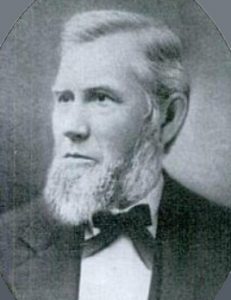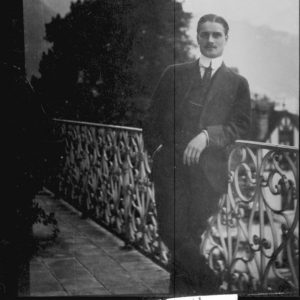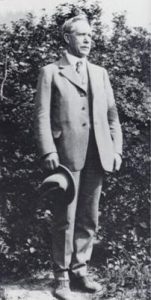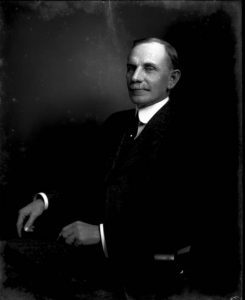A New Name, an Old Company
The 1885 restructuring saw B.D. Buford retire due to health concerns and James.S. Gilmore (sometimes called J.J.) take his place. Louis M Buford stayed on as treasurer briefly but by 1889 F.A. Head, a banker who’s wife was Rock Island, had taken over that role. Local boat works owner William.J. Kahlke took over as secretary soon after the restructuring as well. Kahlke was the owner of a boat works near the plow company factory alongside his brother. Alpheus M. Blakesley had been a board member since 1880 and remained on the board. Besides the Buford’s, another prominent Rock Island family took a major stake in the company, namely P.L. Mitchell and his son Phil Mitchell who also served on boards of two local banks. Phil Mitchell would also invest $20,000 in funds from the Chippiannock Cemetery of which he was a board member, which would cause some controversy. P.L. Mitchell and J.M. Buford were familiar with each other as Mitchell was president of the First National Bank of Rock Island and the Rock Island Savings Bank and J.M was cashier (effectively treasurer of a bank) of both.
Although by 1878 B.D. Buford & Co had begun to be more aggressive in advertising and had started to embrace the branch house system; by the end of 1885 the four branch houses (St Louis, St Joseph, Kansas City and St Paul) had been consolidated into only two at St Paul and Kansas City along with a number of smaller regional distribution offices. It wouldn’t be until 1899 that the Rock Island Plow Company would again expand its branch house network. What the new Rock Island Plow Company did do however was to ramp up advertising. Pocket books and catalogs began to appear in more detail and frequency and advertising in publications became more prominent.
During the 1880’s and 90’s RIPC became involved in a couple of outside ventures.The first of these was the Mast, Buford & Burwell Co of St Paul in 1883. The start of Mast, Buford & Burwell isn’t entirely clear, but for whatever reason, P.P. Mast of Springfield Ohio teamed his powerful Buckeye Agricultural Works with B.D. Buford & Co and J.H. Burwell who acted as treasurer and frontman. The 1885 price list for M,B, & B is the same as the new Rock Island Plow Company’s with only the name changed. Buford did not long remain a partner it appears, as court proceedings show no Buford stock holders in 1892 when it was revealed Burwell had been defrauding the company for years (More on this in the affiliations section).
Another partnership occurred in 1892 W.C. Putnam, N. G. Pendleton and L. C. Jackson incorporated the Star Plow Company of Davenport IA to manufacture plows and implements, with $100,000 in capitol. It was was reported they contracted the Rock Island Plow Company to build them 200 plows to sell in Texas to get started. The plan was to sell plows and cultivators, but aside from the initial announcement, I have found no other information on the company despite Putnams prominence as a local figure (his brother Joseph Duncan (J.D.) Putnam and his mother, Mary Louisa Duncan Putnam were instrumental in the founding of the Davenport IA Putnam Museum and William C. Putnam himself became a successful lawyer, real estate investor and businessman who created an endowment in 1906 that helped fund the Putnam Museum).
After the 1885 reorganization, the Rock Island Plow company entered into a phase of relatively steady growth, expanding into one of the major farm implement companies of the world and claiming such innovations as the frameless sulky plow, the first practical hay loader, and development of the first practical disk harrow by adding scrapers to the blades. Notably, the company made no effort to enter either the steam market or the development of the gas engine/tractor market until Rock Island’s purchase of the “Great Western” line in 1911. In fact, despite being hailed as the farm implement capitol of the world, none of the Tri Cities implement companies made an effort to enter into the steam market.
In late 1900, J.S. Gilmore retired from the board and Phil Mitchell took his place and and also was listed as treasurer, Kahlke remained as secretary. By this time, F.A. Head had become vice president and taken over as manager/superintendent, where he would continue until 1906 when W.I Bogardus took the role of manager.
New Ownership, New Direction
With the Panic of 1907, money again became an issue and Phil Mitchell began divesting the Mitchell Family of assets in the company, selling them to the already influential Weyerhaeuser Family, then still of Rock Island. Although best known today as Weyerhaeuser Lumber; in the 1800 and early 1900’s the Weyerhaeuser-Denkmann family was extremely diverse in its ownership of companies, looking for distressed companies and purchasing them at discounted prices. With the purchase of the Mitchell shares, the Weyerhaeusers took a controlling interest in the Rock Island Plow Company in 1908.In a meeting on the 25th of January 1908, the first transitions to new management took place. President remained Phil Mitchell while John P. Weyerhaeuser took the role of first vice president. W. I. Bogardus became second vice-president and manager. Secretary would be Samuel S. Davis and treasurer would be Fred. C. Denkmann. W. J. Kahlke remained but was now assistant secretary and G. H. Sheldon became assistant treasurer. Sams brother Thomas B. Davis also had a place on the board (Thomas had married Apollonia Denkmann in 1889). Another Rock Island notable, John Hauberg; who was married to Susanne Denkmann also had a place on the board. On the production side no changes were made, A. B. Frenier remained as superintendent, W. A. Johnson, assistant superintendent and designer, and W. H. Johnson superintendent of machinery. A later vote also increased capitol to $2,000,000.
By 1909 Bogardius had become assistant general manager and James F Lardner had taken over as general manager but otherwise little had changed. Despite the 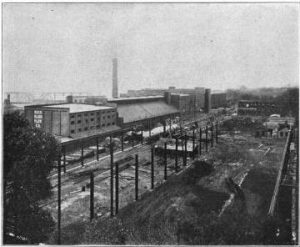 Weyerhaeuser Family likely at this time having the majority stake, Phil Mitchell retained the position of president. It wasn’t until sometime in 1912 or 13 that the Weyerhaeusers finally took full control of the company. S.S. Davis became president and assumed direct control of the company. Lardner still was listed as general manager, but the family now had full control of the board and Davis would now start the day to day management of the company. Lardner would eventually move to the secretary role taking less of a role in direct management of the company.
Weyerhaeuser Family likely at this time having the majority stake, Phil Mitchell retained the position of president. It wasn’t until sometime in 1912 or 13 that the Weyerhaeusers finally took full control of the company. S.S. Davis became president and assumed direct control of the company. Lardner still was listed as general manager, but the family now had full control of the board and Davis would now start the day to day management of the company. Lardner would eventually move to the secretary role taking less of a role in direct management of the company.
Although Davis’s place on the company board came from being the son-in-law of John P Weyerhaeuser (having married Apollonia Weyerhaeuser in 1892) who had driven the Weyerhaeuser-Denkmann investment, Davis in his own right was a prominent businessman. A Rock Island native, he had gone west with his brother and father as rivermen in Colorado. Upon returning to the area he and his brother Thomas entered the plumbing business and formed the Davis Company. The brothers gained the contract to lay the city water lines for Moline in 1883, but the city lacked a the means to build the system so they formed the Moline Water Works Company. The brothers used the Water works to get into electric power generation, eventually providing power to Moline, Davenport and Rock Island using water power from the Arsenal Island Dam. After petitioning the government for a permit, the brothers in 1907 began to rebuild the David B. Sears dam across the Rock River that had been damaged by flooding and abandoned. The new dam featured a modern power house and it was said “that the dam would be good until the river runs dry.” The dam still stands today and was finished in 1912.
The 1907 Panic also cost the Chippiannock Cemetery most of the funds the Mitchells had invested from the Cemetery, $20,000 by that time according to John Hauberg in an interview in 1936. After Davis and Hauberg visited the cemetery and were unable to find graves due to head high weeds, Davis used the plow companies resources to clean the cemetery. According to Haubergs recollections, the near worthless shares in the cemetery were then gathered up by Davis and resold , raising some $7000 to keep the cemetery operational and maintained (Story HERE).
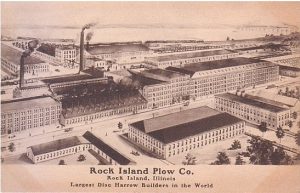 Rock Island’s 1911 purchase of the “Great Western” line from the Smith Manufacturing Co. of Chicago was a major change in the direction of the Rock Island Plow Company. First off, it added an even more diverse array of products to the catalogue, including manure spreaders and cream separators. Advertising of the day featured these items and company also started to include recipes in some of its advertisements and even released a cookbook in 1912 featuring a diverse array of recipes, many strangely high end for a farm cookbook of the day. The other major aspect of this merger was that for the first time the Rock Island Plow company featured power machinery in the form of the Jacob Haish “Great Western” hit and miss engines. Rock Island had sold through the Southern and Eastern Branch Houses Root & VanDervoort engines starting in 1909m and for a time Northern had sold Nelson Little Jumbo engines, but now RIPC had an engine to call its own. Haish of DeKalb IL had been producing the Great Western engines under contract to Smith and continued with RIPC. The “Great Western” engine line was short lived, dropped in favor of Haish’s “Chanticleer” engine line. Besides the Haish Engines, Rock Island would also serve as distributor for the Alamo engine line starting in 1913, and would in fact become Alamo’s single largest distributor. Although Wendel could not corroborate the actual buyout of Smith Mfg, the July 27 1912 implement age carries an article titled “Rock Island Owns Great Western” that unequivocally states “ The facts are that the Rock Island Plow Company bought the line entirely, and from now on will control the patents, good-will and the entire business, and will always build this popular line, and positively insures the perfect construction and entire satisfaction always given by Great Western goods.”
Rock Island’s 1911 purchase of the “Great Western” line from the Smith Manufacturing Co. of Chicago was a major change in the direction of the Rock Island Plow Company. First off, it added an even more diverse array of products to the catalogue, including manure spreaders and cream separators. Advertising of the day featured these items and company also started to include recipes in some of its advertisements and even released a cookbook in 1912 featuring a diverse array of recipes, many strangely high end for a farm cookbook of the day. The other major aspect of this merger was that for the first time the Rock Island Plow company featured power machinery in the form of the Jacob Haish “Great Western” hit and miss engines. Rock Island had sold through the Southern and Eastern Branch Houses Root & VanDervoort engines starting in 1909m and for a time Northern had sold Nelson Little Jumbo engines, but now RIPC had an engine to call its own. Haish of DeKalb IL had been producing the Great Western engines under contract to Smith and continued with RIPC. The “Great Western” engine line was short lived, dropped in favor of Haish’s “Chanticleer” engine line. Besides the Haish Engines, Rock Island would also serve as distributor for the Alamo engine line starting in 1913, and would in fact become Alamo’s single largest distributor. Although Wendel could not corroborate the actual buyout of Smith Mfg, the July 27 1912 implement age carries an article titled “Rock Island Owns Great Western” that unequivocally states “ The facts are that the Rock Island Plow Company bought the line entirely, and from now on will control the patents, good-will and the entire business, and will always build this popular line, and positively insures the perfect construction and entire satisfaction always given by Great Western goods.”
In 1912, RIPC purchased the Chambers, Baring & Quinlan Company, of Decatur, IL. RIPC’s target was their Rakes & Tedders. The C. B. & Q. side-delivery rakes and tedders were well regarded but the C B & Q company also produced planters, drills and hayloaders. These lines were sold to International Harvester, reported in December of 1912 as being completed. The factory was apparently sold off and began producing brass castings. Rock Island had no qualms about capitalizing on the names of the companies they acquired and C.B. &Q was proudly featured next to “Great Western” on advertising.
In 1913 it was announced that although some branch houses had already carried them, RIPC would now sell Peoria Drills and Seeders through all branch houses. Peoria drills and seeders would be a mainstay of the line into the the 30’s. Eventually, Peoria incorporated with other companies to become Farm Tools Inc, which was eventually bought by Ford-Dearborn.
The Era of the Heider Tractor
The next big move for the Rock Island Plow Co. would come in 1914 when they became distributors for the Heider Company run by John and Henry Heider out of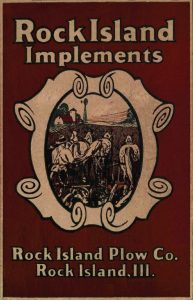 Carroll Iowa. This was a major move as it allowed the company to enter into the new and highly lucrative tractor market. Like their close competitor John Deere, The Rock Island Plow Company had realized farmers were looking for package deals. Companies selling implements alone were severely disadvantaged in the market, so such an alliance was vital. For the Heider’s, it was just as vital; Their innovative friction drive design had proven popular and the company had outgrown its facilities. A new design was in the works, but without assistance it would have proven difficult to bring to market and a major expansion of the Carroll IA factory would have been needed. Again, the new design proved popular, and in 1916 the Rock Island Plow Company purchased the Heider Tractor line from the Heider Company. The Heider Company remained in business for a number of decades producing wagons after the split. Henry Heider worked under contract with the Rock Island plow company until 1922 as an engineer.
Carroll Iowa. This was a major move as it allowed the company to enter into the new and highly lucrative tractor market. Like their close competitor John Deere, The Rock Island Plow Company had realized farmers were looking for package deals. Companies selling implements alone were severely disadvantaged in the market, so such an alliance was vital. For the Heider’s, it was just as vital; Their innovative friction drive design had proven popular and the company had outgrown its facilities. A new design was in the works, but without assistance it would have proven difficult to bring to market and a major expansion of the Carroll IA factory would have been needed. Again, the new design proved popular, and in 1916 the Rock Island Plow Company purchased the Heider Tractor line from the Heider Company. The Heider Company remained in business for a number of decades producing wagons after the split. Henry Heider worked under contract with the Rock Island plow company until 1922 as an engineer.
During the war years of WW1, Heider tractors saw action in Europe attached to various units, especially the 328th Artillery’s Battery B, Horses were expensive, and tractors were proving to be far more reliable and cheaper. The Dutch especially proved fond of the Heider and a number were sold to their military. When armistice was declared Nov 11 1918, A long line of Heider tractors hauling factory workers yelling and waving flags were in the parade. Besides military service, many Heiders were shipped overseas during this time besides sales into Canada. In France, a company called RIP was established as an importer and later produced Heider clones under license.
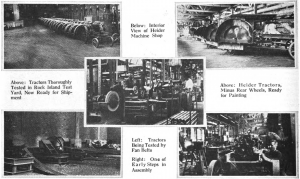 By 1918 Davis was in complete control of the company, but he and the rest of the board members lacked any experience in agriculture beyond the running of the company. The Rock Island Plow Company would continue to use the Heider name through 1926 for their tractors; but a stagnation of innovation, lack of direction and an out of touch philosophy by the Weyerhaeusers meant the Heider friction design slipped behind the modern tractors of the mid 20’s and the name Heider suffered. Although Henry patented new designs such as the Heider motor Cultivator and the Model E, Rock Island lagged in implementing the designs. Rock Island’s implement division on the other hand, was extremely active, releasing innovative designs like the Heider plow lift and the CTX series plows with numerous plow designs. Once noted for reliability and ease of use, the friction drive was outdated technology, and although a brief flurry of updated designs appeared around 1926 and ‘27, friction was no longer a selling point. The decision was made to drop the Heider name and friction drive and switch to a modern transmission design that debuted in 1927 under the Rock Island name.
By 1918 Davis was in complete control of the company, but he and the rest of the board members lacked any experience in agriculture beyond the running of the company. The Rock Island Plow Company would continue to use the Heider name through 1926 for their tractors; but a stagnation of innovation, lack of direction and an out of touch philosophy by the Weyerhaeusers meant the Heider friction design slipped behind the modern tractors of the mid 20’s and the name Heider suffered. Although Henry patented new designs such as the Heider motor Cultivator and the Model E, Rock Island lagged in implementing the designs. Rock Island’s implement division on the other hand, was extremely active, releasing innovative designs like the Heider plow lift and the CTX series plows with numerous plow designs. Once noted for reliability and ease of use, the friction drive was outdated technology, and although a brief flurry of updated designs appeared around 1926 and ‘27, friction was no longer a selling point. The decision was made to drop the Heider name and friction drive and switch to a modern transmission design that debuted in 1927 under the Rock Island name.
During this time, RIPC also partnered with the Newell Sanders Plow Company of Chattanooga to sell Sander’s Disk Plows and would later buy out the line.
New Era
The dropping of the Heider name and the addition of a new design of tractors was a necessary decision, but in retrospect it was too little too late. Despite heavy demand and the factory running night and day, the company was in a money loosing spiral and the Weyerhaeusers were already seeing the company as a liability. Although in a sense this was a high time for the company with new designs including the all new Rock Island Tractor and massive advertising, it was also the beginning of the great depression in 1929 and the Dust Bowl era that would forever change American agriculture.
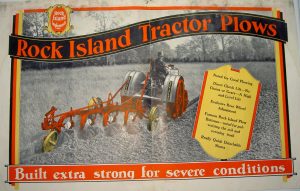 Despite the new designs proving effective and reliable, they were already out of date at their introduction compared to the cutting edge of tractor technology. Only the company’s old reputation for well-backed products, good prices and an aggressive ad campaign made the line successful for a time, but the company was loosing money; and the Weyerhaeusers had no interest in actively managing the company back to profitability, now considering the company only a liability. Leading that charge was F.K. Weyerhaeuser who unsuccessfully tried to convince the family holding company to liquidate the plow company.
Despite the new designs proving effective and reliable, they were already out of date at their introduction compared to the cutting edge of tractor technology. Only the company’s old reputation for well-backed products, good prices and an aggressive ad campaign made the line successful for a time, but the company was loosing money; and the Weyerhaeusers had no interest in actively managing the company back to profitability, now considering the company only a liability. Leading that charge was F.K. Weyerhaeuser who unsuccessfully tried to convince the family holding company to liquidate the plow company.
According to Charles Twining’s – “F.K. Weyerhaeuser: a Biography”: “John agonized, and this time for good reason, over his indebtedness to the Rock
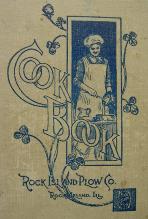
1912 cook book. Downloadable here
Island Plow Company, Brother-in-law Sam Davis’s farm machinery company. In writing to F.K. John didn’t mince words: “I am worried to death.” Twining also quotes in the same book that Weyerhaeuser lawyer Gus Clapp, also in 1929, expressed concerns over the plow company: “where no one knows the business, and all are old, over 70” in reference to the directors of the company.”
Already loosing money and poorly managed, the Great Depression was the lid of the coffin for the company. By the end of 1929, they had effectively ended most advertising; the company was steadily drawing back from the larger market. A major push in 1930 to expand their Canadian market through their old partner the Waterloo Company came with modified designs for the Canadian market. These designs were only on the market briefly before being discontinued. After struggling through the Great Depression, sales began to finally improve in 1934, and new designs began to appear for 1935, but by then the damage was done. The once proud rival to the John Deere Empire lay in financial ruins with a hostile ownership.
